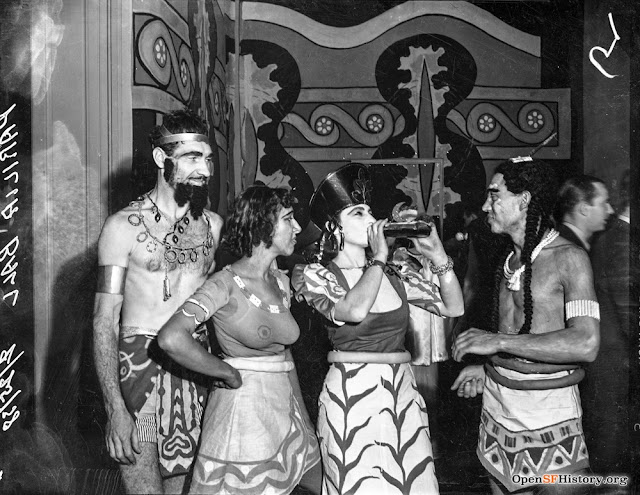Victor Arnautoff, Esther Bruton, and the 1936 Parilia Ball
 |
| Revelers at the 1938 Parilia Ball OpenSFHistory / wnp14.3134.jpg www.opensfhistory.org |
The costumes worn to the Parilia were creative, exotic, and in many cases risque. Newspaper accounts frequently commented on the “bizarre and scanty” outfits worn by attendees.[1] In a 1938 backlash, the organizers insisted that the Parilia was “going in for more modesty, less nudity this year,” although party-goers didn’t get the message and were just as scantily clad as in previous years.[2] With the repeal of Prohibition, the overconsumption of alcohol was inevitable, and the parties frequently got out of control; the day after the 1934 Parilia, the cleanup crew had to “remove a few dozen ‘bodies’ from beneath boxes, behind curtains, and from under tangled decorations.”[3] The 1937 event made the front page of the San Francisco Examiner, when a headline announced “13 injured, 15 jailed in Parilia.”[4] In their defense, party goers complained that the auditorium drinking fountains had been turned off so that the liquor concessions could do more business.[5] The following year, the newspaper reported further debauchery with the headline, “Parilia tame, only 21 drunks land in jail.”[6]
Esther Bruton had her moment in the sun at the 1936 Cambodian-themed Parilia Ball, which was held in the San Francisco Civic Auditorium. Timothy Pflueger was in charge of the event; having just worked with Esther on the enormously successful Cirque Room (to be discussed in a future blog post), it is no surprise that he selected her as his “Queen Naga.” Pflueger chose another of his favorite artists, Victor Arnautoff, to be king. The San Francisco Examiner managed to misspell both artists’ names when it announced that “Esther Brunton” and “V. Arnatoff” would be the King and Queen of the 1936 Parilia.[7] The error was corrected the following day when the paper printed a photograph of Bruton and Arnautoff in costume.
 |
| Victor Arnautoff and Esther Bruton, 1936 San Francisco History Center, San Francisco Public Library |
[1]San Francisco Examiner, 17 Jan. 1936, p. 17.
[2]San Francisco Examiner, 16 Feb. 1938, p. 34.
[3]San Francisco Examiner, 21 Jan. 1934, p. 19.
[4]San Francisco Examiner, 7 Feb. 1937, p. 1.
[5]San Francisco Examiner, 7 Feb. 1937, p. 3.
[6]San Francisco Examiner, 27 Feb. 1938, p. 18.
[7]San Francisco Examiner, 31 Dec. 1935, p. 15.
[8]“Cambodian Pageant: Artists Ball Colorful and Resplendent.” Architect and Engineer, Feb. 1936, p. 33-35.
[9]Quoted in “Cambodian Pageant: Artists Ball Colorful and Resplendent.” Architect and Engineer, Feb. 1936, p. 35.
[10]San Francisco Examiner, 18 Jan. 1936, p. 11.
[11]Interview, 26 Feb. 1975, p. 16.




Comments
Post a Comment